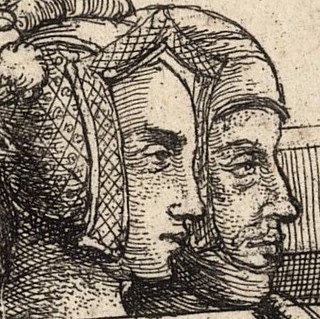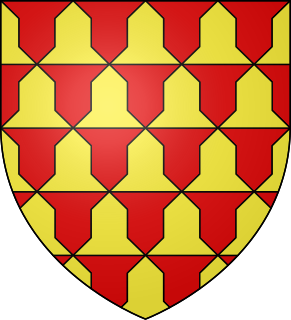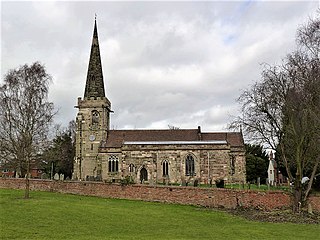
Tutbury is a village and civil parish in Staffordshire, England. It is 5 miles (8.0 km) north of Burton upon Trent and 20 miles (32 km) south of the Peak District. The village has a population of about 3,076 residents. It adjoins Hatton to the north on the Staffordshire–Derbyshire border.

Ralph de Stafford, 1st Earl of Stafford, 2nd Baron Stafford, KG, of Stafford Castle and Madeley Castle in Staffordshire, was an English nobleman and a notable soldier during the Hundred Years' War against France.

Staffordshire is a landlocked county in the West Midlands of England. It adjoins Cheshire to the north west, Derbyshire and Leicestershire to the east, Warwickshire to the south east, West Midlands and Worcestershire to the south, and Shropshire to the west. The historic county of Staffordshire includes Wolverhampton, Walsall, and West Bromwich, these three being removed for administrative purposes in 1974 to the new West Midlands authority. The resulting administrative area of Staffordshire has a narrow southwards protrusion that runs west of West Midlands to the border of Worcestershire. The city of Stoke-on-Trent was removed from the admin area in the 1990s to form a unitary authority, but is still part of Staffordshire for ceremonial and traditional purposes.

Blanche of Lancaster was a member of the English royal House of Plantagenet and the daughter of the kingdom's wealthiest and most powerful peer, Henry of Grosmont, 1st Duke of Lancaster. She was the first wife of John of Gaunt, the mother of King Henry IV, and the grandmother of King Henry V of England.

Henry de Ferrers, magnate and administrator, was a Norman who after the 1066 Norman conquest was awarded extensive lands in England.
William I de Ferrers, 3rd Earl of Derby was a 12th-century English Earl who resided in Tutbury Castle in Staffordshire and was head of a family which controlled a large part of Derbyshire known as Duffield Frith. He was also a Knight Templar.
Sir Oswald Mosley of Ancoats, 2nd Baronet was a British politician and writer.

Robert de Ferrers, 6th Earl of Derby (1239–1279) was an English nobleman.

Melbourne Castle was a medieval castle in Melbourne, Derbyshire. It was built on the site of an earlier royal manor house that had provided accommodation for noblemen hunting in a nearby royal park in the reign of King John. Construction of the castle was started in 1311 by Thomas, 2nd Earl of Lancaster, and continued until 1322, shortly before his execution, but the work was never fully completed.

Bull running was a custom practised in England until the 19th century. It involved chasing a bull through the streets of a town until it was weakened, then slaughtering the animal and butchering it for its meat. Bull running became illegal in 1835, and the last bull run took place in Stamford, Lincolnshire, in 1839. The practice was not confined to any particular region, with bull runs also documented at Axbridge in the south west, Canterbury and Wokingham in the south east, Tutbury in the midlands, and Wisbech in the east.
Priory of St. Thomas near Stafford was an Augustinian religious house near Stafford, Staffordshire, England. Founded sometime in approximately 1174, it was a surrendered to the Crown in 1538, during the Dissolution of the Monasteries.
Tutbury Priory was a Benedictine monastery in Tutbury, Staffordshire, England, founded in 1080 by Henry de Ferrers as a dependency of the abbey of Saint-Pierre-sur-Dives in Normandy and completed in 1089, in memory of King William the Conqueror and his wife Queen Matilda of Flanders, also of Henry de Ferrers' own parents, and in thanksgiving for his own family: "in honour of holy Mary, the Mother of God ... and for the soul of King William and Queen Mathilda, and for the health of my father and mother, and my wife Berta, and my sons, Engenulph, William and Robert, and my daughters and all my ancestors and friends."

The Battle of Burton Bridge was fought between Royalist and Parliamentarian forces at Burton upon Trent on 4 July 1643 during the First English Civil War. By the time of the battle, the town, which had at various times been held by both sides, was garrisoned by a Parliamentarian unit under the command of Captain Thomas Sanders and the town's military governor, Colonel Richard Houghton. The key river crossing at Burton was desired by Queen Henrietta Maria, who was proceeding southwards from Yorkshire with a convoy of supplies destined for King Charles I at Oxford. The Royalists, led by Colonel Thomas Tyldesley, launched a cavalry charge across the bridge which succeeded in defeating the Parliamentarians and capturing most of their officers, including Sanders and Houghton. The Queen's convoy proceeded on its way south to Oxford, with Tyldesley receiving a knighthood and a promotion in recognition of his victory. Burton changed hands several more times during the course of the war, before finally coming under Parliamentarian control in 1646.

The 1322 Battle of Burton Bridge was fought between Thomas, 2nd Earl of Lancaster and his cousin King Edward II of England during the Despenser War. Edward's army was proceeding northwards to engage Lancaster, having defeated his Marcher Lord allies in Wales. Lancaster fortified the bridge at Burton upon Trent, an important crossing of the River Trent, in an attempt to prevent the King from proceeding. Edward arrived at nearby Cauldwell on 7 March 1322 and intended to use the ford at Walton-on-Trent to cross the river and outflank Lancaster. Edward was delayed for three days by floodwaters, during which time some of his force was deployed opposite Lancaster's men at the bridge.

Black Ladies Priory was a house of Benedictine nuns, located about 4 km west of Brewood in Staffordshire, on the northern edge of the hamlet of Kiddemore Green. Founded in the mid-12th century, it was a small, often struggling, house. It was dissolved in 1538, and a large house was built on the site in Tudor and Jacobean styles by the Giffard family of Chillington Hall. Much of this is incorporated in the present Black Ladies, a large, Grade II*-listed, private residence.

Sir Richard Vernon was an English landowner, MP and speaker of the House of Commons.

Sir Godfrey de Foljambe was a prominent landowner and politician in fourteenth-century England, who was a Baron of the Exchequer and chief steward of the duchy of Lancaster. He went on to have a successful career as an Irish judge, including three years as Lord Chief Justice of Ireland. He was initially a servant of Philippa of Hainault before becoming a prominent member of the affinity of her son, John of Gaunt, Duke of Lancaster. His tomb can still be seen at All Saints Church, Bakewell.
Sir John Cockayne was an English soldier, politician and landowner whose wealth made him a major force in the affairs of Derbyshire under the House of Lancaster. After numerous acts of criminality in concert with other Midlands landowners, he became a member of the Lancastrian affinity centred on John of Gaunt and a supporter of Henry IV. He fought in two campaigns of the Hundred Years War but his violence and lawlessness continued and he was decidedly out of favour during the reign of Henry V. With power less concentrated in the early years of Henry VI, he was able to serve three terms as High Sheriff of Nottinghamshire, Derbyshire and the Royal Forests and to wield considerable power and influence. He represented Derbyshire no less than nine times and Warwickshire twice in the House of Commons of England.

The Tutbury bull run was a blood sport that took place in Tutbury, Staffordshire, from the 14th century until 1778. It formed part of the annual Court of Minstrels, a ceremonial legal proceeding for travelling musicians in the nearby counties. The Tutbury bull run is first recorded in 1414 but may be of earlier origin, though a story that it was begun by John of Gaunt to remind his Spanish wife of home is believed false. The bull was provided to the minstrels by Tutbury Priory and, after the Dissolution of the Monasteries, by the Duke of Devonshire. The bull would be chased through the town by the minstrels who could claim it if it was caught. It was afterwards baited to death and served in a feast. The event developed into a competition between Staffordshire and Derbyshire residents who competed to catch the bull within their own counties. After the decline of the Court of Minstrels the bull run developed into a drunken revel. It was abolished in 1778 after a man was killed during a mass brawl.

St Mary's Church is a parish church of the Church of England in Rolleston on Dove, Staffordshire. Parts of the structure date to 1130, though it was extensively renovated in 1892. It is unusual in having the main entrance door on the north side, with the southern entrance reserved for members of the Mosley family, local landowners and key donors to the church. The church features stained glass windows dating to the medieval period and others by Victorian designer Charles Eamer Kempe. The tower houses eight bells, one dating to 1586. The church is grade I listed and there are associated grade II listings for churchyard railings, a memorial, the lychgate and a former church grammar school. The lychgate, by Lincolnshire architect Cecil Greenwood Hare, also functions as a war memorial.















